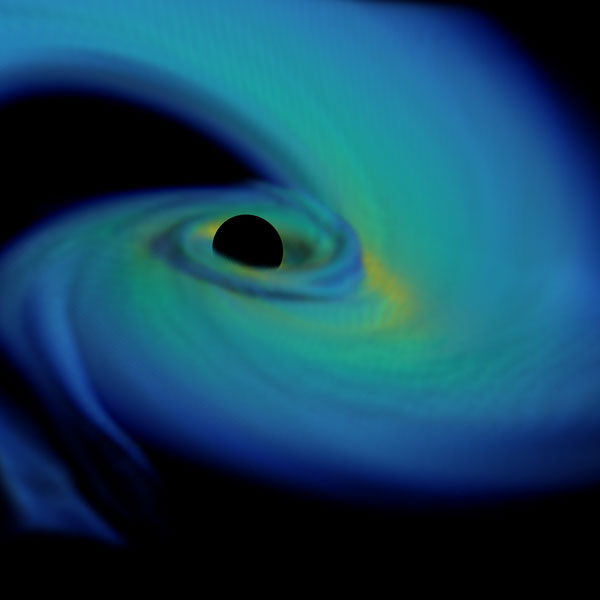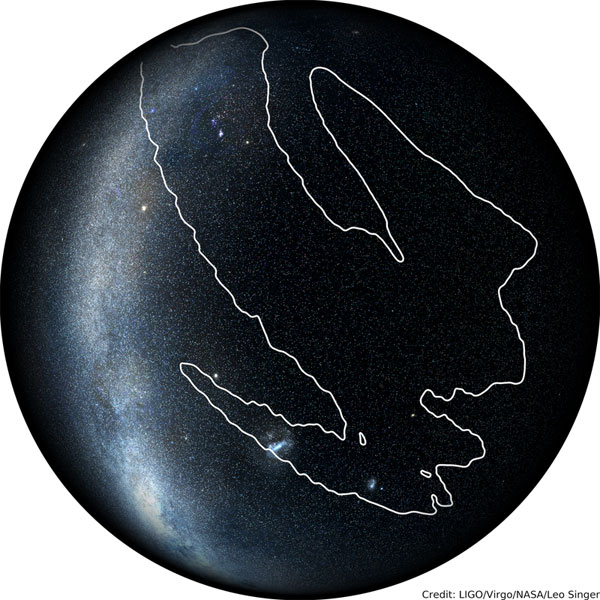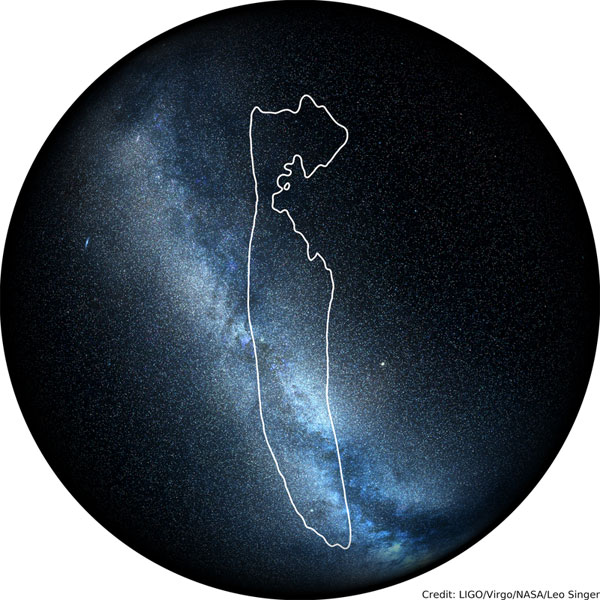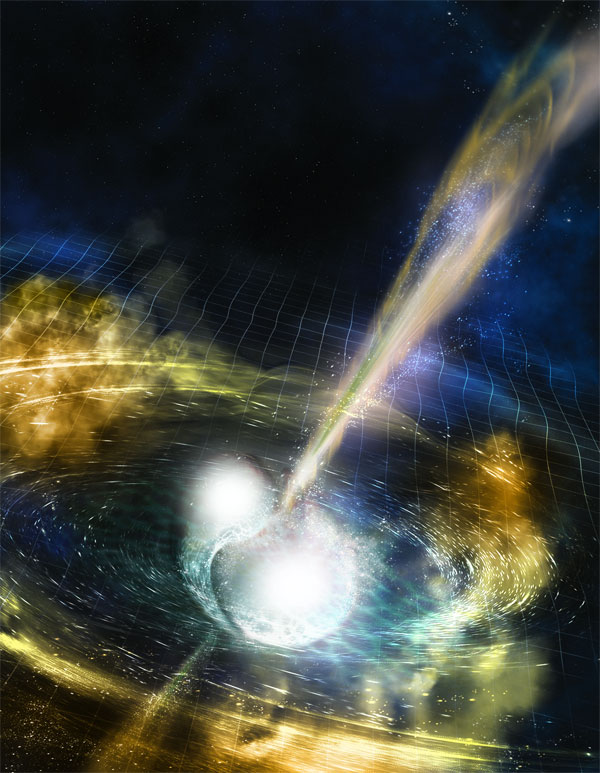Only a month into a new observing run, gravitational-wave observatories have announced five new signals — one of which could turn out to be a black hole swallowing a neutron star.

F. Foucart (U. of New Hampshire) / SXS Collaboration / Classical and Quantum Gravity, 34, 4 (2017)
It wasn’t so long ago that scientists announced the very first detection of gravitational waves. Now, only three years later, major improvements to both the Laser Interferometer Gravitational-wave Observatory (LIGO) in the U.S. and the Virgo observatory near Pisa, Italy, are promising to make those discoveries commonplace.
In the first month of their third observing run, which runs from April 2019 to April 2020, LIGO and Virgo have already detected five gravitational wave signals, ripples in spacetime that began their journey in cataclysmic crashes billions of light-years away. These are candidate events, which means they’re not fully vetted yet. Indeed, one of these candidates might turn out to be a fluke, but two others appear to be bona fide black hole mergers, while a fourth appears to be a neutron star crash. The most tantalizing, though, is the fifth and most recent mashup: a black hole swallowing a neutron star.
| Designation (based on date detected) | Likely Source | False alarm rate* |
| S190408an | Two black holes | one in 100 years |
| S190412m | Two black holes | one in 2 x 1019 years |
| S190421ar | Two black holes | one in 2 years |
| S190425z | Two neutron stars | one in 70,000 years |
| S190426c | Black hole and neutron star | one in 1 year, 7 months |
* The false alarm rate describes how often we'd expect to see a similar signal by chance, rather than due to a real event. Gravitational-wave detectors have been running for just over a year total, between three observing runs, so events with equivalent false alarm rates may turn out to be flukes.
Gravity and Light

LIGO / Virgo / NASA / Leo Singer (Milky Way image: Axel Mellinger)
Unlike the previous discoveries, which were carefully vetted and confirmed as real sources before being announced to the public, we’re hearing about these new events right away. That’s because finding electromagnetic radiation (i.e., light) from these gravitational-wave sources is crucial to understanding them. Immediate announcements means that telescopes on the ground and in space can set to observing the sky near these gravitational-wave sources at once.
While black hole pairs aren’t expected to produce light, it sure would be exciting if they did. More importantly, astronomers do expect inspiraling neutron star pairs to produce brilliant flashes of light across the electromagnetic spectrum. Observing this radiation would help shed light on these explosive events, but also on more fundamental physics. Astronomers can make use of colliding neutron stars to test general relativity, for example, and measure the expansion of the universe.
Unfortunately, no one has found any counterparts for the candidates reported so far. Part of that is because when the neutron star pair collided, one of the detectors — the LIGO instrument in Hanford, Washington — was briefly offline.
“Sometimes the local ground motion gets too high, or the alignment is disrupted for some other reason, and our control systems can't keep the optics steady enough, which causes the detector to go offline,” says Jessica McIver (LIGO). Hanford went offline at 7:55 UT on April 25th, right before gravitational waves from the neutron star collision passed through the detector.
Isolating the instruments from those extra sources of motion is exactly why the European Space Agency wants to launch the Laser Interferometer Space Antenna (LISA); a technology demo has already flown successfully (and surpassed expectations), but we’ll have to wait til the mid-2030s before we start seeing gravitational waves from space. (These gravitational waves will also come from different sources — supermassive rather than stellar-mass black holes.)

LIGO / Virgo / NASA / Leo Singer (Milky Way image: Axel Mellinger)
If all three LIGO and Virgo detectors are working together, they can pinpoint a source to within hundreds of square degrees. But with Hanford briefly out of commission, the sky area to comb through expanded to 10,000 square degrees. And while all three detectors were online when the signal from the black hole – neutron star collision passed over Earth, its signal was weak. “It’s like listening to somebody whisper a word in a busy café,” says LIGO spokesperson Patrick Brady (University of Wisconsin, Madison). “It can be difficult to make out the word or even to be sure that the person whispered at all. It will take some time to reach a conclusion about this candidate.”
Despite the challenges involved, the game’s not over yet — astronomers are still in the process of observing the sky for possible counterparts. “We do have one tantalizing candidate remaining for which the jury is still out,” says Mansi Kasliwal (Caltech). “We are collecting more information and I hope to be able to say more soon.”
The Long Haul
It’s important to keep in mind that everything that the LIGO team has announced so far is preliminary. There’s still a lot of work to be done in removing noise and isolating the signals, and some of the conclusions may change. It’s just that this time around, we get to see science in action. “Properties of the event may change as we do deep analysis and follow-up,” McIver explains. “We [may] also see the statistical significance of these events change over time.”

NSF / LIGO / Sonoma State University / A. Simonnet
Still, five candidates in one month is an auspicious start. The team had expected to find a few black hole mergers per month — that’s LIGO and Virgo’s “bread and butter.” But with only a single neutron star collision observed in 2017, predictions for this observing run had ranged from one neutron star merger a month to one a year. Finding one in April already is promising, even if we’ve lost the chance to find its light counterpart. If things keep going the way they’ve been going, we can expect to see many more.
Even more intriguing is the possibility of finding different types of gravitational waves. Not that black holes whirling around each other at half the speed of light before coalescing into a monstrous pit in spacetime is boring! But with the improvements to LIGO and Virgo’s sensitivity, scientists are hoping for the ability to “hear” events such as supernova explosions, single spinning neutron stars, or maybe something altogether new.
How to Take Part
Gravitational waves are a hefty topic. But even if you’re not a professional scientist, there are ways to help open this new window on our universe.
To detect gravitational waves, the detectors need to measure motions 1,000 times smaller than the nucleus of an atom. So removing other, much larger motions — from earthquakes, trucks driving near the detectors, and other noise — is crucial to detecting any signal at all. A fascinating project called Gravity Spy combines citizen science with artificial intelligence to do just that.
First, citizen scientists peruse examples of detector noise, classifying different types of so-called “glitches.” Then a computer algorithm called a convolutional neural network (the same kind of algorithm inside self-driving cars) trains on these examples and actually learns how to recognize each glitch as it appears in the data. “This combination has been incredibly powerful for characterizing LIGO and Virgo detector noise,” McIver says.
Amateur astronomers with access to a telescope can help out, too. Telescopes around the world are trying to find light coming from the same source that’s producing the gravitational waves, and backyard telescopes can do that job as well. Amateurs can sign up to receive automatically generated notices of gravitational-wave detections here. Light counterparts are most likely going to come from neutron star collisions, so in the event that another neutron star pair merges, you can click over to an auto-generated galaxy catalog here. Find more (albeit, rather technical) information on getting involved here.
 1
1









Comments
TorbjornLarsson
May 4, 2019 at 10:00 am
Very interesting and thorough, thanks!
"Finding one in April already is promising, even if we’ve lost the chance to find its light counterpart."
Yes, it was bitter sweet to follow the loss since the first detection raised expectations of "another one like it". I know that down the line the data on neutron stars innards that we may see from black hole-neutron star mergers will be interesting - and it was a new discovery - but right now I am more excited by the binary neutron star merger. The first one allowed an entirely independent (though uncertain) measure of local Hubble rate, and just another data point would be interesting to see if it keeps coming in between the different local (supernova only) and the global (all data) rates.
I hear we don't even need 100ish of binary neutron star mergers from the naive statistical estimate to get uncertainty down to 1/10 of today, but perhaps 20-30? So hopefully 2-3 years instead of the 5ish years that was initially mentioned.
You must be logged in to post a comment.
You must be logged in to post a comment.